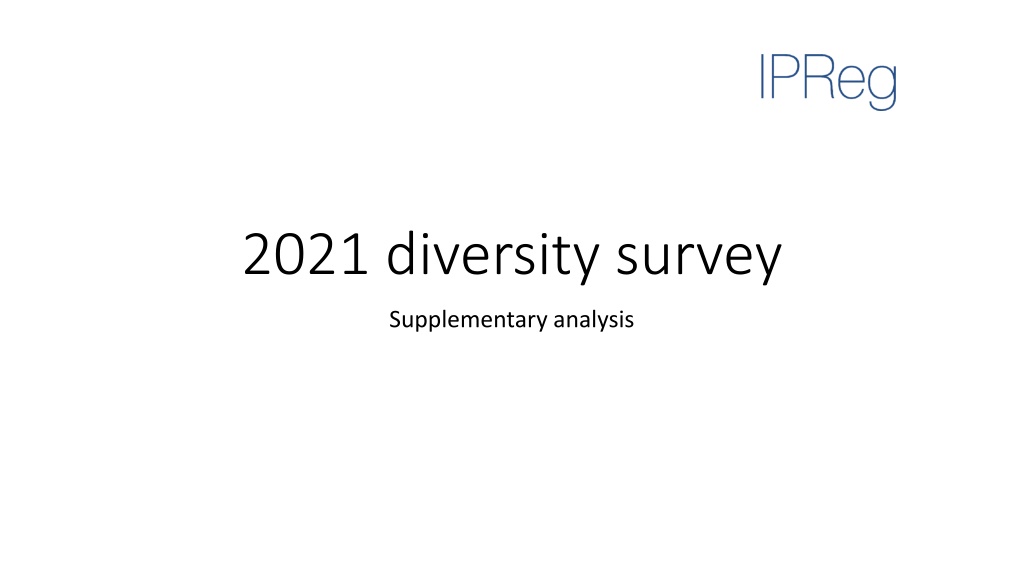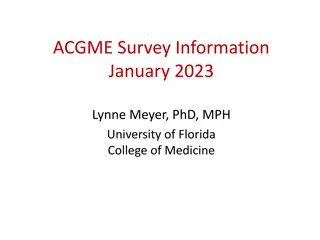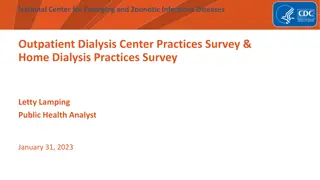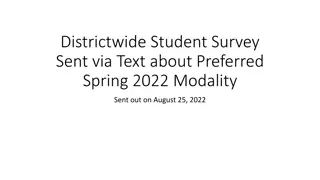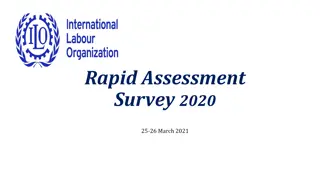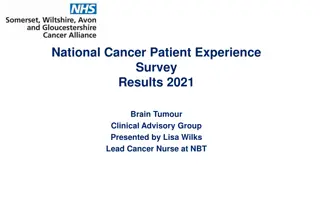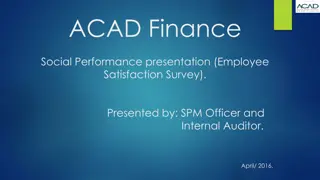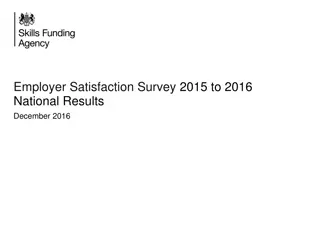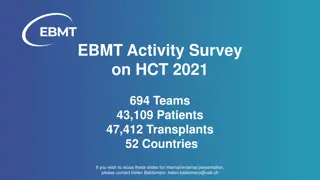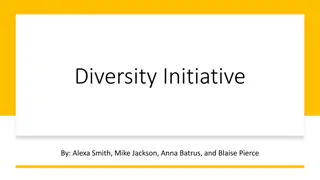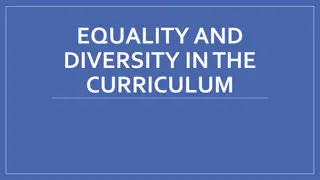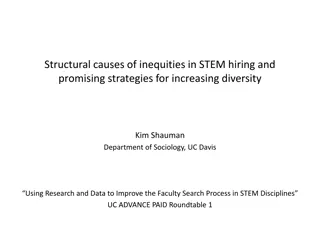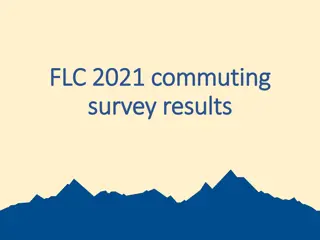Diversity Survey 2021 Supplementary Analysis
The 2021 Diversity Survey Supplementary Analysis reveals positive progress in gender, ethnic group, disability, age, sexual orientation, caring responsibilities, and recruitment/progression within the legal profession. While improvements have been made in certain areas, gaps persist, particularly in the representation of Black attorneys and individuals with disabilities. The survey highlights the importance of continued efforts to promote diversity and inclusivity in the workplace.
Download Presentation

Please find below an Image/Link to download the presentation.
The content on the website is provided AS IS for your information and personal use only. It may not be sold, licensed, or shared on other websites without obtaining consent from the author. Download presentation by click this link. If you encounter any issues during the download, it is possible that the publisher has removed the file from their server.
E N D
Presentation Transcript
2021 diversity survey Supplementary analysis
Survey Results (All) Gender, Ethnic Group and Disability We are pleased to report that since our last survey in 2017, the profession has increased its diversity. The number of female and attorneys with disabilities has increased and is now closer to the UK benchmark, whilst the diversity in ethnicity is broadly constant, albeit at or close to the benchmark. However, there is still work required to fully close the gaps, particularly with respect to the employment of people with a disability and Black attorneys. Gender Ethnic Group Disability Female Total Asian Black Multiple/Mixed Other 2021 Respondents 42% 10% 8% 1% 1% 0% 4% 2021 LSB Benchmark 47% 12% 5% 3% 4% 0% 15% 2017 IPReg survey 33% 11% 2% 0% 1% 6% 1%
Survey Results (All) Age, Sexual Orientation and Transgender The profession has a slightly older profile than the UK benchmark, and has a greater proportion of people who do not have a religion. However, it is broadly in line/slightly more diverse with respect to sexual orientation and transgender. Sexual Orientation Age Profile Gender Identity LGB 16-24 25-34 35-44 45-54 55-64 65+ Not regst Sex at birth 2021 Respondents 0% 18% 34% 30% 13% 4% 6% 1% 61% 2021 LSB Benchmark 11% 23% 4% 3% 1% NA 2017 IPReg survey NA NA
Survey Results (All) Caring responsibilities The respondents report a significant level of attorneys balancing their work with caring responsibilities. Again, this is broadly in line with the data reported by other legal services regulators. This was more prevalent for respondents in senior positions and reinforces the point that changing expectations of working from home, as a result of the coronavirus pandemic, mean that a good employer should ensure that flexible working is taken into account. Caring Responsibilities Child Adult 2021 Respondents 35% 9%
Survey Results (All) Male/Female profile by Age The survey shows a more balanced male/female profile in the younger age groups. This may reflect the increasing majority of female university entrants and graduates (reported at 56% in 2018-19) and/or the higher proportion of patent attorneys with STEM qualifications gained before 1990 (which tended to be male-dominated). Gender Split by Age Group 90% 80% 70% 60% 50% 40% 30% 20% 10% 0% 25-34 35-44 45-54 55-65 65+ Prefer not to say Female Male
Survey Results (All) Recruitment & Progression There are positive signs about the recruitment and progression of younger people, ethnic groups and women. There is a caveat that that the sample size of junior respondents is relatively small and may not be fully representative of the profession. IPReg is examining this point in greater detail. Seniority By Age 100% 90% 80% 70% 60% 50% 40% 30% 20% 10% 0% Junior Middle Senior 25-34 35-44 45-54 55-64 65+ Prefer not to say
Survey Results (All) Recruitment & Progression Seniority By Ethnic Groups 25% 20% 15% 10% 5% 0% Junior Middle Senior Ethnic Groups (Total) Ethnic Groups Asian Ethnic Groups Black Ethnic Groups Mixed Ethnic Groups Other
Survey Results (All) Recruitment & Progression The profession s senior ranks reflect a higher (59%/40%) male/female ratio than the average for the profession as a whole (48%/42%) (and the LSB benchmark of 47% female in the UK workforce). Again, this may reflect the historically male-dominated STEM degree requirement for patent attorneys. However, it is encouraging to note the relative increase in female respondents in middle and junior positions. Seniority By Gender 70% 60% 50% 40% 30% 20% 10% 0% Junior Middle Senior Male Female Other/Prefer not to say
Survey Results (All) Social Mobility Social mobility is one of the harder criteria to measure. In common with other regulators, we sought responses about education at fee-paying schools and whether the attorney was the first in their family to obtain a degree-level qualification. Social Mobility Fee-paying School Parents with Degree 2021 Respondents 24% 54%
Survey Results (All) Business Type Our profession has a considerable range of business types and the approach to increasing diversity may differ between them. Whilst larger practices or sub-groups of in-house businesses may already have greater resources and incentives to address EDI issues, we recognise that smaller businesses and sole traders may require focused support and assistance in implementing EDI action plans. Business Sector Business Size Private Practice Small (<20 emps) Medium/Large (>20 empl) In-house Other Other 2021 Respondents 18% 74% 8% 23% 72% 5%
Survey Results (All) Business Type This view is reinforced by the observation that medium/larger businesses have slightly greater gender and ethnic diversity , whilst smaller businesses have a higher proportion of people with disabilities. Gender Ethnic Group Disability Female Total Asian Black Multiple/Mixed Other 2021 Small Businesses 41% 9% 7% 1% 1% 0% 7% 2021 Med/Large Businesses 43% 10% 8% 1% 1% 0% 3% 2021 IPReg Total 42% 10% 8% 1% 1% 0% 4% 2021 LSB Benchmark (All) 47% 12% 5% 3% 4% 0% 15%
Survey Results (Patent and Trade Mark) Gender, Ethnic Group & Disability In terms of the change since the 2017 survey, it appears that the diversity of trade mark attorneys is changing at a faster rate than patent attorneys; again, this may reflect the STEM requirement for entry to the patent attorney profession. Gender Ethnic Group Disability Female Total Asian Black Multiple/Mixed Other Patent Attorneys 38% 9% 8% 0% 1% 0% 4% Trade mark Attorneys 68% 16% 7% 5% 4% 0% 6% Dual registrants 19% 4% 3% 0% 1% 0% 4% 2021 Total Respondents 42% 10% 8% 1% 1% 0% 4% 2021 LSB Benchmark 47% 12% 5% 3% 4% 0% 15%
Survey Results (Patent and Trade Mark) Age Profile Despite the observations above, it does appear that attorneys on both registers have a higher proportion of older (>45 years) respondents than either the patent or trade mark attorney groups. Broadly, those who are only enrolled on one of the registers, have an equal proportion of <45 years, in their cohort.
